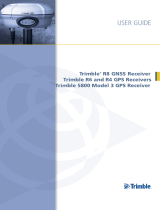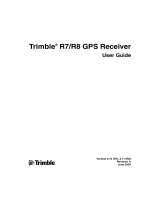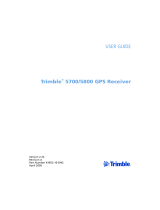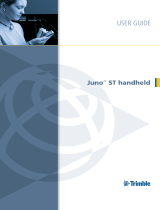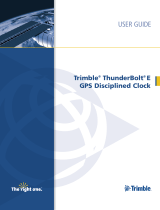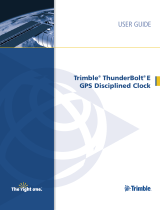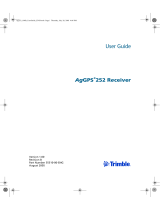
Regulatory information
For full legal and regulatory information, please go to https://receiverhelp.trimble.com/r780-gnss.
USA
FCC Compliance Statement
Model Numbers: R780
FCC IDs: JUPR750M566-90,
JUPR750M566-60
FCC Class B - Notice to Users. This device complies with part 15
of the FCC rules.
RESPONSIBLE PARTY:
Trimble Inc.
10368 Westmoor Drive
Westminster CO 80021
USA
trimble.com/Corporate/Contacts.aspx
This device complies with Part 15 of the FCC Rules. Operation is
subject to the following two conditions: (1) this device may not
cause harmful interference, and (2) this device must accept any
interference received, including interference that may cause
undesired operation. Changes or modications made to this
equipment not expressly approved by Trimble Inc may void the
FCC authorization to operate this equipment.
FCC Certied Modular Transceiver
The TRM900 (902.0 MHz to 928.0 MHz) Limited Singular-
Modular Transceiver is only approved for use by Trimble in its own
GNSS Receiver products and not intended for sale to third parties.
This module is not intended for OEM integrators or end users.
As a Limited Single Module, additional compliance evaluation is
required for use in each of the GNSS Receiver host.
The TRM900 was tested and certied with a monopole antenna
(868MHz-940MHz, 2.5dBi max gain, TPN66540-10). The
connector type was RP-TNC.
The TDL450i (403.0 MHz to 473.0 MHz) Singular-Modular
Transceiver was tested and certied with a monopole antenna
(400MHz-512MHz, -2dBi max gain, TPN44085-60). The
connector type is also RP-TNC.
Canada
This device contains licence-exempt transmitter(s)/receiver(s)
that comply with Innovation, Science and Economic Development
Canada’s licence-exempt RSS(s). Operation is subject to the
following two conditions:
• This device may not cause interference.
• This device must accept any interference, including
interference that may cause undesired operation of the device.
L’émetteur/récepteur exempt de licence contenu dans le présent
appareil est conforme aux CNR d’Innovation, Sciences et
Développement économique Canada applicables aux appareils
radio exempts de licence. L’exploitation est autorisée aux deux
conditions suivantes :
(1) l’appareil ne doit pas produire de brouillage;
(2) l’appareil doit accepter tout brouillage radioélectrique subi,
même si le brouillage est susceptible d’en compromettre le
fonctionnement.
Under Industry Canada regulations, this radio transmitter may
only operate using an antenna of a type and maximum (or lesser)
gain approved for the transmitter by Industry Canada. To reduce
potential radio interference to other users, the antenna type and
its gain should be chosen so that the equivalent isotropically
radiated power (EIRP) is not more than that required for
successful communication.
Conformément à la réglementation d’Industrie Canada, le présent
émetteur radio peut fonctionner avec une antenne d’un type et
d’un gain maximal (ou inférieur) approuvé pour l’émetteur par
Industrie Canada. Dans le but de réduire les risques de brouillage
radioélectrique à l’intention des autres utilisateurs, il faut choisir
le type d’antenne et son gain de sorte que la puissance isotrope
rayonnée équivalente (PIRE) ne dépasse pas l’intensité nécessaire
à l’établissement d’une communication satisfaisante.
This Class B digital apparatus complies with Canadian ICES-003.
Cet appareil numérique de la classe B est conforme à la norme
NMB-003 du Canada.
This apparatus complies with Canadian RSS-GEN, RS-102,
RSS-247.
Cet appareil est conforme à la norme CNR-GEN, CNR-102,
CNR-247 du Canada.
8















